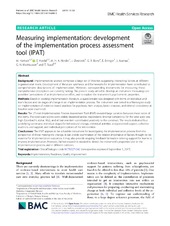| dc.contributor.author | Hartveit, Miriam | en_US |
| dc.contributor.author | Hovlid, Einar | en_US |
| dc.contributor.author | Nordin, Håkan | en_US |
| dc.contributor.author | Øvretveit, John | en_US |
| dc.contributor.author | Bond, Gary R. | en_US |
| dc.contributor.author | Biringer, Eva Aaker | en_US |
| dc.contributor.author | Assmus, Jörg | en_US |
| dc.contributor.author | Mariniusson, Gerd Haugen | en_US |
| dc.contributor.author | Ruud, Torleif | en_US |
| dc.date.accessioned | 2020-06-22T10:23:46Z | |
| dc.date.available | 2020-06-22T10:23:46Z | |
| dc.date.issued | 2019-10-21 | |
| dc.Published | Hartveit M, Hovlid E, Nordin H, Øvretveit J, Bond GR, Biringer EA, Assmus J, Mariniusson, Ruud T. Measuring implementation: development of the implementation process assessment tool (IPAT). BMC Health Services Research. 2019;19:721 | eng |
| dc.identifier.issn | 1472-6963 | |
| dc.identifier.uri | https://hdl.handle.net/1956/22793 | |
| dc.description.abstract | Background Implementation science comprises a large set of theories suggesting interacting factors at different organisational levels. Development of literature syntheses and frameworks for implementation have contributed to comprehensive descriptions of implementation. However, corresponding instruments for measuring these comprehensive descriptions are currently lacking. The present study aimed to develop an instrument measuring care providers’ perceptions of an implementation effort, and to explore the instrument’s psychometric properties. Methods Based on existing implementation literature, a questionnaire was designed with items on individual and team factors and on stages of change in an implementation process. The instrument was tested in a Norwegian study on implementation of evidence based practices for psychosis. Item analysis, factor structure, and internal consistency at baseline were examined. Results The 27-item Implementation Process Assessment Tool (IPAT) revealed large variation between mean score of the items. The total scale scores were widely dispersed across respondents. Internal consistency for the total scale was high (Cronbach’s alpha: .962), and all but one item contributed positively to the construct. The results indicated four underlying constructs: individual stages for behavioural change, individual activities and perceived support, collective readiness and support, and individual perceptions of the intervention. Conclusions The IPAT appears to be a feasible instrument for investigating the implementation process from the perspective of those making the change. It can enable examination of the relative importance of factors thought to be essential for implementation outcomes. It may also provide ongoing feedback for leaders tailoring support for teams to improve implementation. However, further research is needed to detect the instrument’s properties later in the implementation process and in different contexts. | en_US |
| dc.language.iso | eng | eng |
| dc.publisher | BMC | eng |
| dc.rights | Attribution CC BY | eng |
| dc.rights.uri | http://creativecommons.org/licenses/by/4.0/ | eng |
| dc.title | Measuring implementation: development of the implementation process assessment tool (IPAT) | en_US |
| dc.type | Peer reviewed | |
| dc.type | Journal article | |
| dc.date.updated | 2020-01-31T14:15:49Z | |
| dc.description.version | publishedVersion | en_US |
| dc.rights.holder | Copyright 2019 The Author(s) | |
| dc.identifier.doi | https://doi.org/10.1186/s12913-019-4496-0 | |
| dc.identifier.cristin | 1741144 | |
| dc.source.journal | BMC Health Services Research | |

